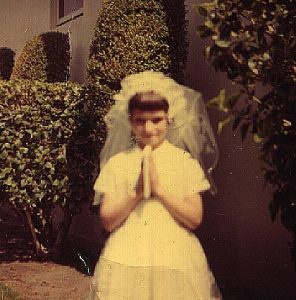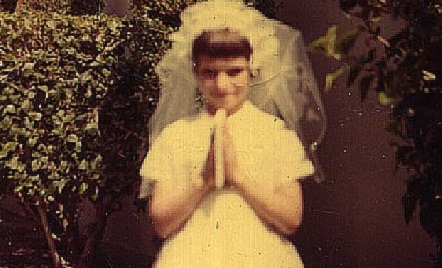From Ritual to Relationship – Jackie Alnor
As a baby boomer, I was raised in a large Roman Catholic family during the 1950s and 60s in Los Angeles County, USA. I have many fond memories, and painful ones as well, of growing up Catholic. I was the middle child in a large close-knit family of nine children, and we were all educated in Catholic school. My dad was our church’s choir director, and my mom was the local president of Catholic Daughters. We had a Mary shrine in a grotto in our back yard, and there was a crucifix hanging on the wall in our living room filled with holy candles, holy water from Lourdes, and oil, which I was told was kept in case of an emergency.
My Catholic indoctrination focused on the so-called “mysteries of the Church.” I was taught to believe Catholic dogma, whether it made sense to me or not, because the Pope had the keys to the kingdom, and what he says goes. Catholic mysticism had a superstitious tone in my upbringing. My Catholicism was a hodgepodge of sacraments and superstition, the sort of thing that the Catholic Church winks at but does not fully condone. My family would never miss Mass on Sundays and holy days for fear of staining our souls, and yet we saw nothing wrong with following horoscopes and using Ouija boards for fun and games.
I remember attending Mass as a youngster and being trained to whisper and show utmost respect for the mysterious presence of the Lord in the tabernacle. I would get goosebumps during the High Mass when the incense would fill the church. In my child-like understanding, the priest was closer to God than we who were in the pews. I had a fascination with religious sacramental statues, icons, and relics. They were both seductive and repelling to me. One of my earliest memories was walking into a neighbor lady’s house to be greeted by a life-sized, bloody “Christ” hanging on a cross amid lit candles. I always got the heebie-jeebies visiting over there.
I remember my mother taking me to a strange Catholic celebration, the May Crowning, held at the Los Angeles Coliseum. I recall being afraid of the crowd of people there in the packed stadium. All eyes were on a larger-than-life statue of the “Virgin Mary” that was being carried in procession up to a podium where she was crowned with a wreath of beautiful roses. The crowd, hushed with a sense of awe, some with tears in their eyes, was reciting the rosary while staring transfixed at the statue. I was hot, tired, and happy to get out of there; yet, I was puzzled at what all of this meant.
My dad would sometimes take me to a church in Los Angeles where he would attend Mass on his way to work. It was called St. Vibiana’s Cathedral. It looked like something right out of the Middle Ages. The place was dark and empty, and while my dad knelt at the altar to pray, I stared up at the strangest site above the altar. There was a glass case with the body of a beautiful dead lady inside. He told me that the body was of St. Vibiana, and her body never saw corruption, i.e., it would never decay. Dad said it was a miracle, however, they had to encase the body in wax to help preserve it better. That was the biggest relic I had ever seen, and I was awestruck being in its presence. When I saw the film “House of Wax,” I thought of St. Vibiana during the scene where the madman, played by Vincent Price, was about to encase the beautiful leading lady in hot wax to preserve her beauty for all eternity.
When I was in the first or second grade, the nuns showed us a film in our school auditorium. It was a “so-called” true story of a young boy, Saint Marcellus. This boy was an orphan raised by monks somewhere in Europe. He was always in trouble, mostly because of being misunderstood. As a mischievous child myself, I really related to him. He used to sneak into the “attic” library, where he was not allowed to go, so he could look at a life-sized crucifix. As the story goes, one day a scorpion stung him, and he managed to get into some other trouble. He ran up to the attic where he felt comforted by the statue. That day, while he cried at the foot of the cross, the statue came to life and came down from the cross. It held and comforted him.

I was profoundly affected by this story, wondering why Jesus would do that for him and not for me. I, too, was a victim of being misunderstood. So, I would go to the altar of our church where a bigger-than-life sized crucifix hung above the altar. This “Jesus” of mine was made out of gold. In addition, I would pray to it and ask it to come to life and talk to me. However, it was all to no avail! Then, in the fourth grade, my mother was directing a school celebration of the Feast of the Immaculate Conception. She cast me in a little skit that depicted the Fatima Marian apparition appearing to the three children. I was able to play one of them. A statue of Mary was put high on a podium and the other children and I knelt onto kneelersi, and we were to pretend to be in a trance state with our hands folded in prayer. We were to stare up at the lady while the choir sang the Ave Maria. I was struck with the story of Fatima and hoped for an apparition to appear to me.
I used to wear a scapularii around my neck because one of the Marian apparitions had promised that if you die wearing one (with Mary’s image on it), she would get you out of the fiery Purgatory the first Saturday following your death. I also had a “miraculous medal” of Mary, and I think that one promised to spring me out of Purgatory after only three days. However, just to be sure, I still prayed all the little novena prayers that promised me some indulgences, i.e., time off from my purgatorial sentence.
One ritual in the Catholic Church that intrigued me was the Stations of the Cross. This is a ceremony held every Friday during Lent where more scripture verses are read than in any other Catholic ritual. We would follow the “Passion” of Christ, showing how He was brutally scourged, mocked, and nailed to the cross. One of the twelve stations showed St. Veronica wiping Jesus’ face with her veil and an image of his bloody face miraculously appeared on it. I never could find the Bible verse that told that part of the crucifixion story. However, my heart would be touched so deeply while reading the Gospel accounts that I would walk away from there with a real sense of remorse that He had to suffer for my sins.
Unanswered Questions
My first memory of questioning what I was being taught by the adults in my life was when I was around ten years old. Walking home from school with my sisters, wearing my uniform, some kids from the public elementary school began teasing us for being Catholics. I approached one and asked, “Why don’t you like us? What have we done?” The little boy responded, “You worship statues and light candles to them, and one of the Ten Commandments says not to make any molten images.”
I was flabbergasted. I ran the rest of the way home, went straight to my mom, and asked her if that was true. She said that we do not pray to statues, but only to what they represent. I asked about the commandment, and she explained to me that they did not list it as a commandment because it is the same as the first commandment: to love the Lord God. I was somewhat relieved, but I still felt something was not quite right.
I could not understand the meaning of the daily Mass, especially since I learned the liturgy in Latin. I could say every response, yet I had not the slightest idea of what I was saying. I took pride in myself that I could say those mysterious words so well. I felt I was doing something religious when I would have to fast for three hours before communion and when I would abstain from eating meat on Fridays. Then of course, it was a sin not to, and I did not want to have any black stains on my soul.
At the age of twelve, during the time I was being prepped for receiving my Confirmation, Vatican II changes began to take effect at our church. I was told it was no longer necessary to fast before communion, and I could now eat meat on Fridays, except during Lent. The Mass was now said in English instead of Latin, therefore it seemed to lose some of its mysteriousness.
I was filled with doubts and suspicions. I asked myself, “How can truth change, and how can something send you to hell one week and not the next?” I wondered, “What about those who were already in hell for committing the sins that are no longer sinful?” I could not reconcile these things in my mind. It was at this time in my life that I began to mistrust all adults in authority.
Vatican Council II, in essence, said to me that the Catholic Church authorities were admitting they were wrong about something and that their claims of infallibility were a cosmic joke. I knew that truth does not change, although I had never heard the scripture verse: “Jesus Christ, the same yesterday, today, and for ever.”iii I no longer had any confidence in their teachings since I knew the teachings could change with the next Church Council.
When the day of my Confirmation came, and I was to have hands laid on me by the bishop, my doubts were nagging at me. I did not want to go through with the ceremony, but I did not have any choice in the matter. The bishop also wanted my Confirmation class to take an oath never to drink alcohol, and we were told to stand up and swear not to ever drink. I stayed seated, as did a few others, because though I was not interested in drinking booze, I knew my dad drank, the priests drank wine at Mass, and I did not want to promise something I might not be able to keep. Nevertheless, I never did acquire a taste for alcohol.
The Dark Ages
By the time I was in high school, I wanted nothing whatsoever to do with church. My parents insisted that I go to Mass as long as I lived under their roof. Therefore, I would walk into the church, grab a bulletin, leave, and then show them the bulletin when they asked me if I went to Mass. I told them I got nothing out of going, but they did not care. I still had to go.
I lost all confidence in my parents and the Catholic Church, and I am sure those attitudes contributed to my rebellious nature. At the age of seventeen I left my home, located in a Los Angeles suburb, to join my hippie friends in northern California. I wanted nothing at all to do with religion, although I still had an interest in Ouija boards and astrology. I was also advancing into other occult practices, such as tarot cards and palm reading.
It did not take long for me to fall into great trouble and despair. I ended up pregnant by my hippie boyfriend who was already trying to distance himself from me before I discovered my condition. My first impulse was to run to “Mother Church.” Since I was miles from home, alone, and scared, I sought refuge in a Catholic church in San Jose, California, where confessions were being heard. I confessed my sins and told the priest what peril I was in, being 17, pregnant, far from home and without a job, money, or a high school diploma. I was astounded that the priest did not want to discuss my problem; he dismissed me with a penance of ten “Hail Marys” and five “Our Fathers.”
I never did the penance; I was devastated! I went home to southern California where I was sent to St. Anne’s, a Catholic home for unwed mothers in Los Angeles. I was given a pregnant nun as a roommate. As a nun, she had taken a vow of silence, so she was not much company. I gave birth to a beautiful baby girl, and I was forced to give her up for adoption because nobody would take us in.iv
I continued to nominally believe in the Lord Jesus Christ, but I felt let down by His church. I would go to Mass on Easter and midnight Mass every Christmas for the next ten years. I had some sort of strange connection to “Mother Church,” however, my many questions about the truth of its teachings prevented me from any further involvement; but it was the only religion I knew. I pushed the questions out of my mind and filled the emptiness in my life with partying and drugs.
I became an avid reader and belonged to the “Book of the Month Club.” I looked forward to reading anything I could get my hands on if it was exciting and spooky. Stephen King was my favorite author. However, one day I got a book in the mail called, “Michelle Remembers.” It was supposed to be a true story given by a girl while under hypnosis. It tells of her recalling hidden memories of a childhood of satanic, ritualistic abuse. As she gave the gruesome details of watching human sacrifices and mutilations while in a trance state, she would manifest ugly welts on her skin in the shape of the devil’s tail. The book included photographs of this phenomenon.
This book really scared me. I had just finished reading a book called “The Entity,” which was another “true” story of a Los Angeles woman being sexually assaulted by unseen demons, and between these two books, I was convinced of the existence of the devil. I said to myself, “If the devil is real, and I believe he is, then there must be a God.”
From Futility to Faith
I went to the local Catholic bookstore and bought a Catholic Bible. I began reading the Old Testament. I thought I knew the New Testament already, but I was only slightly familiar with the four gospels. The Bible began to be a source of encouragement to me and I was becoming convinced that it was truly God’s word to man. I felt comforted knowing that God was real too; that the devil was not stronger than God.
However, my life did not change much just because I was again open to matters of faith. I was going through a difficult time at the close of a bad relationship, and I was facing another Christmas alone. At twenty-seven years of age, I felt like an old maid. Most of my sisters and friends had married and divorced already, and I was always the proverbial “bridesmaid.” Christmas was particularly hard because everyone would gather at my parents’ house with their spouses and children, and I would be alone in their midst.
So, for the first Christmas in my life, I attended a Christian church instead of Mass for Christmas. I went to the only church I knew of that taught the Bible, and that was Calvary Chapel of Costa Mesa. The pastor, Chuck Smith, taught that day on the pagan roots of Christmas that originated from the winter’s solstice of Saturnalia. I was very much amused by it and amazed by what he was saying. I was impressed. The people did not look at all like the Jesus Freaks I had envisioned. I held on to the bulletin, put it in my nightstand drawer, and forgot about it.
I periodically read the Bible until a personal crisis brought me to the end of myself. I came under intense conviction of my sinfulness while reading the Gospel of John. I cried out to God to save me and I was determined under the convicting power of the Holy Spirit to forsake my way of life and turn the reins over to Jesus Christ. However, I did not know how to pray. It was three o’clock in the morning, and I felt disgusted with myself, but I did not know how to present my petitions to the Lord.
I opened my nightstand drawer and pulled out the Calvary Chapel bulletin. Here it was, the Fourth of July, and I had held onto it since the previous Christmas. It had the phone number of a 24-hour prayer hotline. I dialed the number expectantly. The first words out of my mouth when the guy answered was “Help me! I want to pray and I do not know how. I have been a Catholic all my life and we always recited Hail Mary’s and other prayers, but that will not do for me now. I want to know how to pray in the right way.”
I was choked up and found it hard to speak. There was silence for what seemed like an eternal minute on the other end of the line. Maybe the guy did not know if I was for real. However, he led me to the sixth chapter of Matthew and said, “When Jesus gave the Lord’s prayer it wasn’t meant to be recited by rote.” He read, “But when ye pray, use not vain repetitions, as the heathen do: for they think that they shall be heard for their much speaking. Be not ye therefore like unto them: for your Father knoweth what things ye have need of, before ye ask him. After this manner therefore pray ye…”v
As he read the Lord’s Prayer, I followed along in my Bible and saw the words “Our Father” as if for the very first time, as though blinders had been removed from my eyes. He prayed with me, and I wept with the most cleansing tears ever shed in my life. From that moment on my spiritual eyes were opened and I began to read the Bible with understanding. Every verse I read revealed more about God and His Son, Jesus, and I could not get enough of this life-giving manna from heaven. For several months, whenever I spoke to others of what Jesus had done for me, I could barely hold back my tears of gratitude.
Family Reaction
The first person I called to share the excitement was my mom. She listened to my testimony, and my words brought her to tears. I found out later that she had assumed that I was going to come back to “Mother Church” now that I was taking the Lord seriously. However, I had no inclination to darken the doorway of a Catholic church again. I had not found the truth in that system. Even as I read my Catholic Bible, I refrained from reading the footnotes of the Catholic interpretations it contained. I wanted to hear directly from God, not from man’s opinion of God. I wanted truth—the truth—God’s truth! I knew the reality of deception since I had been deceived already. Moreover, I did not want to end up in any religious cult or under any man’s control. I had to know the mind of Christ, and I could only do that by reading His word.
As I studied the “Catholic Bible,” so many scripture verses would condemn ideas I had been taught growing up. I discovered Bible verses that would outright condemn such Catholic ideas as Purgatory, Transubstantiation, indulgences, prayers to saints, Mary worship and the like. However, what frightened me the most was when I read the seventeenth chapter of the book of Revelation. I could not deny the familiarity of the description of the Mother Harlot: “arrayed in purple and scarlet colour, and decked with gold and precious stones and pearls, having a golden cup in her hand full of abominations and filthiness of her fornication.”vi
I felt such a sense of betrayal by Rome. I mourned over her for a long time, but I had to put her out of my life—she was an imposter! I tried not to let my disgust with Rome affect my love for my parents and other well-meaning Catholic relatives.
The Lord is My Shepherd!
As I reflect on my life, I see the Lord’s hand on me from the beginning. He directed my steps even when I was not aware of His presence. My salvation is based on Christ’s finished work on the cross of Calvary. That is, He died to pay the penalty for my sins. I can add “nothing” to that great atonement. Sure, my life is lived in a more pure manner as a Christian than it ever was as a Catholic, but none of my selfless works adds to my worthiness before my perfect Savior. He has given me a gift—one I did not earn.
I love Jesus so much because, like the woman in the Bible who had the alabaster box, those who have been forgiven much—love much.vii There are several verses of scripture I have held onto since I first was saved. These passages helped to establish me in the faith, “was once delivered to the saints.”viii Romans 10 is one that I have returned to again and again since my born-again experience that took me from darkness to light on that Independence Day, 25 years ago. I leave you with its wisdom, “The word is nigh thee, even in thy mouth, and in thy heart: that is, the word of faith, which we preach; That if thou shalt confess with thy mouth the Lord Jesus, and shalt believe in thine heart that God hath raised him from the dead, thou shalt be saved. For with the heart man believeth unto righteousness; and with the mouth confession is made unto salvation. For the scripture saith, whosoever believeth on him shall not be ashamed.”ix
If you wish to contact me please do so.
My email address is: jackie.alnor@gmail.com
i Kneeler: a cushion or bench for kneeling on
ii A scapular is a necklace that hangs down both in front and in back, with a small, flat rectangular pendant at each end. A scapular is worn under clothing in an inconspicuous manner. Traditional scapulars are made out of brown cloth similar to that worn by Carmelite nuns. They can also be made out of leather, various colored cloth, vinyl or plastic. Small scapulars can represent a certain devotion or spiritual idea from a community. These scapulars have two pieces of cloth (generally about an inch square), connected by cords and worn over the head. It often has a picture or a particular color, depending on the spirituality it stands for.
iii Hebrews 13:8
iv We found each other twenty-six years later. We are friends, and she is a Christian. Praise the Lord!
v Matthew 6:7-9
vi Revelation 17:4
vii Luke 7:36-50
viii Jude 1:13
ix Romans 10:8-11


